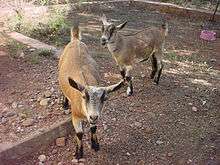Nigerian Dwarf goat
 A 6-month-old doe | |
| Country of origin | West Africa |
|---|---|
| Traits | |
| Height |
|
| |
The Nigerian Dwarf goat is a miniature goat breed of West African ancestry. The original animals were transported from Africa on ships as food for captured carnivores being brought to zoos; the survivors were then maintained in herds at those zoos. Nigerian Dwarf goats are popular as pets and as milkers due to their easy maintenance and small stature.
Characteristics
There are two different height standards for the Nigerian Dwarf goat. The height standard maintained by the American Goat Society and the American Dairy Goat Association requires does to be less than 22.5 inches (57 cm) at the withers, and bucks to be less than 23.5 inches (60 cm) at the withers. The Nigerian Dwarf Goat Association states does should ideally be 17–19 inches (43–48 cm) in height, with a maximum allowed height of 21 inches (53 cm), and bucks should ideally be 19–21 inches (48–53 cm), with a maximum allowed height of 23 inches (58 cm).
They come in many colors: white, black, gold, red, cream and patterns such as buckskin (brown with a black cape over the head and neck along with other black markings) and chamoisee (similar to an Oberhasli goat), with or without white spots.[1] Some have white "frosting" on the ears. Both the Nigerian Dwarf Goat Association and the American Goat Society websites feature pages that include color descriptions, disqualifying features and conformation. Although most are naturally horned, generally breeders disbud them at a young age (usually less than 2 weeks of age) for safety to the goat, its herd mates, and human caregivers. Some Nigerian Dwarf goats have blue eyes, which is a dominant trait in goats.
Milk
The Nigerian Dwarf does give a surprising quantity of milk for its size. Its production ranges from 1 to 8 pounds of milk per day (one quart of milk weighs roughly 2 pounds), with an average doe producing about 2.5 pounds of milk per day. Production depends upon genetics, how many times the doe has freshened (given birth), quality and type of feed, and general good management. Since Nigerians breed year-round, it is easy to stagger freshening in a herd for year-round production of milk. Thus, they are ideal milk goats for most families. Their milk has a higher butterfat content than milk from full-sized dairy goats, averaging 6.5% according to the American Dairy Goat Association.[2] Later in lactation, butterfat can go up to 10% or even higher. This makes Nigerian Dwarf goat milk excellent for cheese, soap and cream making.
Care

Nigerian Dwarf goats are gentle and intelligent.[1] This, along with their small size and colorful appearance, makes them popular as pets. Some breeders bottle-feed kids, which makes them more bonded with humans. Others prefer to let their mothers raise them naturally, finding bottle-fed kids to be overly clingy and noisy. Adult goats should not live in the house; they should instead have an outdoor pen. As ruminants, they need to spend a large part of the day eating, typically up to 14 hours a day. Like all goats, un-castrated bucks are aggressive and have an objectionable odor. They are easy birthers with very few birthing problems. Though problems may occur and it is always best to be prepared at all times.
Sources
- David, Taylor. Nigerian Dwarf Goats Care: Dairy Goat Information Guide to Raising Nigerian Dwarf Dairy Goats as Pets.
- Niemann, Deborah. Raising Goats Naturally: A Complete Guide to Milk, Meat, and More.
- Belanger, Jerry. Storey's Guide to Raising Dairy Goats: Breeds, Care, Dairying.
- Damerow, Gail. Your Goats: A Kid's Guide to Raising & Showing.
References
- 1 2 "Goat, Nigerian Dwarf". Cleveland Metroparks Zoo. Archived from the original on 7 January 2014. Retrieved 24 May 2013.
- ↑ "American Dairy Goat Association". American Dairy Goat Association. Retrieved 27 June 2014.
External links
| Wikimedia Commons has media related to Nigerian Dwarf (goat). |